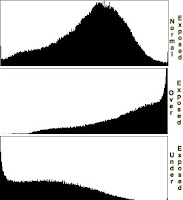Digital photography histogram is a great tool you can use to control the exposure on a picture. When you first saw a histogram it was probably a mystery to you. Here's a simple explanation that will help you Understanding a digital photography histogram.
Most digital cameras have the ability to display a histogram on the LCD screen, but most people using those cameras know nothing about the value of histograms.
A Digital Photography Histogram a kind of graph that displays the exposure levels in a picture. The brightness levels are shown on the horizontal axis of the graph. The left side represents the darkest pixels and the the right the brightest. The space in the middle of the horizontal axis represents midtones. The vertical axis represents the number of pixels.
The farthest left side of the graph shows the number of pixels that have been recorded as black and the farthest right side shows the number of pixels that have been recorded as white. Look at the gradient at the bottom of the histogram I just drew to get a better idea of what I mean.
I know it doesn't exist, but let's just say that you had a 1 pixel camera and you took a picture in a dark room. The picture would be completely dark. The camera would only record one black pixel and it would look like this. (Read about Tips for Photograph Candlelit)
Conversely, if you took a very bright overexposed picture with your 1 pixel camera the histogram would look like this.
Since you don't have a one pixel camera your histogram isn't really going to look anything like the ones above. Here's an example of what the digital photographyp histogram looks like on the back of my camera.
For the purposes of this tutorial we're only looking at the top histogram which is the one that measures the exposure. Now you may be thinking that this is all well and good but what practical purpose does it serve in my photography? Let me tell you.
The useful thing about a digital photography histogram is that it can tell you when your picture is over or underexposed even if you can't tell by just looking at the image on the LCD screen.
It can also tell you if your image is clipped. That means that there are lots of pixels in the image that are at an exposure level the camera cannot read. If most of the pixels are pushed against the left edge of the graph with a steep drop off that means that the picture is too dark and you're losing a lot of detail in the picture.
If there is a steep drop off with much of the graph pushed to the right the picture is too bright. Instead of recording detail your camera has just recorded them as white. In both of these instances you should adjust your exposure to get more detail into your picture.
Many cameras have an exposure warning. The areas of the image that aren't properly exposed will be highlighted on the screen when you view the image with the histogram letting you know that you should adjust the exposure. You can see the area in the clouds that are shaded.
Refer to your histogram often when you take pictures so you get used to it. With practice you'll be able to get more information about the exposure levels in your pictures than you will be able to from simply looking at the image on the LCD.
It can also tell you if your image is clipped. That means that there are lots of pixels in the image that are at an exposure level the camera cannot read. If most of the pixels are pushed against the left edge of the graph with a steep drop off that means that the picture is too dark and you're losing a lot of detail in the picture.
If there is a steep drop off with much of the graph pushed to the right the picture is too bright. Instead of recording detail your camera has just recorded them as white.
In both of these instances you should adjust your exposure to get more detail into your picture.
Many cameras have an exposure warning. The areas of the image that aren't properly exposed will be highlighted on the screen when you view the image with the histogram letting you know that you should adjust the exposure. You can see the area in the clouds that are shaded black in this image. That means those areas are overexposed.
Related Article Perfect Exposure using Histogram.





















